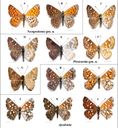Emesidini
Emesidini
Classification
- Phylum: Arthropoda
- Subphylum: Hexapoda
- Class: Insecta
- Order: Lepidoptera
- Superfamily: Papilionoidea
- Family: Riodinidae
- Subfamily: Riodininae
- Tribe: Emesidini
Pronunciation
How to pronounce Emesidini: /ɛˈmɛsɪˌdaɪniː/
These audio files are automatically generated. While they are not always 100% accurate, they are a good starting point.
Images






Summary
The tribe Emesidini encompasses the genus Apodemia, which includes various species of metalmark butterflies known for their striking coloration and wide distribution across the Americas.
Physical Characteristics
Metalmark butterflies are known for their distinctive metallic wing markings, which vary among species.
Identification Tips
Look for small to medium-sized butterflies with vibrant metallic colors on their wings. Specific patterns and coloration can help identify individual species.
Habitat
Emesidini butterflies inhabit a range of environments from grasslands and meadows to wooded areas, primarily in New World regions.
Distribution
Apodemia species are found from Canada to Brazil, suggesting a broad distribution in the Americas.
Diet
Adult butterflies typically feed on nectar from flowers, while larvae may feed on various host plants.
Life Cycle
Like most butterflies, they undergo complete metamorphosis: egg, larva (caterpillar), pupa (chrysalis), and adult stages.
Reproduction
Reproduction generally involves females laying eggs on host plants suitable for the larvae.
Predators
Common predators include birds and other insects that feed on butterflies and caterpillars.
Ecosystem Role
Pollination is a significant role played by adult butterflies in their ecosystems, contributing to the reproduction of many flowering plants.
Cultural Significance
Butterflies have symbolic significance in many cultures, often representing transformation and beauty.
Collecting Methods
- netting adult butterflies
- raising caterpillars from eggs
Preservation Methods
- pressing specimens
- drying specimens for display
Similar Taxa
Tags
- butterflies
- metalmarks
- riodinidae
- Apodemia
- Emesidini